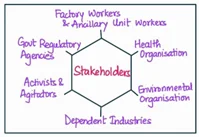Answer:
| Approach:
Introduction
- Shortly analyze the case study.
Body
- Mention how would you approach such situation
Conclusion
|
Introduction:
Severe environmental impact and health problems caused by the industrial chemical factory. Government’s initial approval and subsequent closure of the factory due to public outcry. Economic consequences, including unemployment and negative impact on dependent industries.

Body:
As a senior officer entrusted with handling the issues arising from the closure of the industrial chemical factory, I would approach the situation with the following steps:
- Assess the Environmental Damage: Conduct a thorough assessment of the environmental damage caused by the industrial effluents. This includes evaluating the impact on land, water sources, and crops, as well as the health problems faced by humans and animals in the area.
- Engage with Stakeholders: Initiate dialogue with affected stakeholders, including the local community, workers, ancillary unit employees, and industries dependent on the chemicals manufactured by the factory. Understand their concerns, grievances, and the socio-economic impact of the factory closure.
- Mitigate Immediate Impact: Prioritize the well-being of the affected workers and their families. Work with relevant government agencies and organizations to provide immediate support, such as unemployment benefits, job placement assistance, and skill development programs to help them transition to alternative employment opportunities.
- Environmental Remediation: Collaborate with environmental experts and organizations to develop a plan for environmental remediation. This may involve cleaning up polluted land and water sources, implementing sustainable farming practices, and providing healthcare facilities to address the health problems caused by pollution.
- Support Alternative Industries: Identify and promote alternative industries that can flourish in the area and provide employment opportunities to the affected workers. Encourage diversification and attract investments in sectors that align with sustainable development and have a lower environmental impact.
- Strengthen Environmental Regulations: Advocate for stricter environmental regulations and enforcement to prevent similar incidents in the future. Work closely with the government and regulatory bodies to ensure compliance with environmental standards and promote sustainable industrial practices.
- Community Development: Implement community development initiatives to uplift the affected community. This may include infrastructure development, education and skill-building programs, healthcare facilities, and support for sustainable agriculture practices.
- Public Awareness and Engagement: Conduct public awareness campaigns to educate the community about environmental issues, their rights, and the importance of responsible industrial practices. Encourage public participation in decision-making processes and involve them in monitoring and reporting any environmental concerns.
Conclusion:
By adopting a holistic approach that addresses the immediate and long-term impacts of the factory closure, while prioritizing environmental remediation and socio-economic development, we can strive for a balanced resolution that safeguards the environment, supports affected individuals, and promotes sustainable growth in the region.
